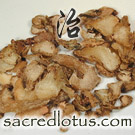Bai Ji (Bletilla Rhizome)
Herb 2 of 19 in Herbs that Stop Bleeding
Buy This Herb
Get free shipping from
our partners at CHD
our partners at CHD
Chinese Herb Actions
-
Restrains Leakage of Blood and Stops Bleeding
For Hematemesis, Hemoptysis, Lung Abscesses, and bleeding due to trauma. - Nourishes Yin, Cools Heat, and Preserves Body Fluids
For bleeding in the Lungs and Stomach causing Hematemesis, Hemoptysis, and Epistaxis. - Reduces Swelling and Promotes Generation of Flesh
Can be applied topically to treat ulcers, sores, swellings, and chapped skin. It can reduce the swelling of sores, and speed the healing of chronic non-healing sores.
Chinese Herb Contraindications & Cautions
- Do not use in cases where hemoptysis is caused by external disease.
- Do not use in early stage Lung abscesses.
- Do not use when bleeding is due to excess fire and toxins.
Herb-Drug Interactions
- Section not completed...
Chinese Herb Toxicity & Overdose
- Section not completed...
Chinese Herb Dosage
- 3-10 grams
Chinese Herb Notes
- The powdered form of this herb is usually mixed with the strained decoction.
- This herb is effective topically to stop bleeding from traumatic injury.
Chinese Herb Combinations:
- Bai Ji (Rhizoma Bletillae)
- San Qi (Radix Pseudoginseng)
Combined Actions:Combined Indications:
- Stops Bleeding, Dispels Blood Stagnation, and Generates Flesh
Combined Use:
- Vomiting of blood (hematemesis)
- Coughing of blood (hemoptysis)
- Bleeding due to traumatic injury
- Used externally on affected area for traumatic injury
This herb is incompatible with:






